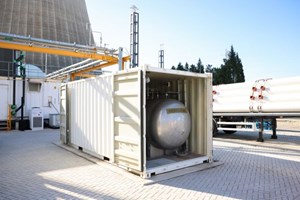News
EDP produces its first H2 molecule in Europe
As part of the FLEXnCONFU project, EDP has taken a significant step in the development of new technologies by producing H2 and successfully injecting it into the gas turbine at the Ribatejo combined cycle power plant.
EDP marks a historic milestone by producing the group’s first H2 molecule in Europe and injecting it into a gas turbine in a real industrial environment. This initiative is part of the European FLEXnCONFU project and was carried out at the Ribatejo combined cycle power plant, located in the Lisbon region. The goal is to validate the practical application of H2 and natural gas co-combustion under operational conditions—a solution still largely unexplored in the energy sector.
The announcement of the first H2 molecule produced by EDP in Portugal was made during the inauguration of the demonstrator—a 1.25 MW electrolyzer—which is part of the broader FLEXnCONFU project (FLExibilize combined cycle power plant through power-to-X solutions using non-CONventional FUels), funded by the European Union’s Horizon 2020 program. The project is led by an international consortium of 21 partners from 10 European countries, including Portugal, Spain, France, Italy, the United Kingdom, Greece, Germany, Belgium, Sweden, and the Netherlands. The inauguration ceremony at the Ribatejo plant was attended by the Portuguese Minister for Environment and Energy, Maria da Graça Carvalho, EDP’s CEO, Miguel Stilwell d’Andrade, and representatives from the European Commission, among other guests.
FLEXnCONFU aims to demonstrate how combined cycle power plants can become more flexible and efficient by integrating different technologies and enabling more sustainable operations in a market increasingly dominated by renewable energy. The project includes two demonstrators that will convert electricity into H2 or ammonia and co-fire them with natural gas. The demonstrator led by EDP in Ribatejo uses H2, while a second one in Italy uses ammonia as an energy carrier—a substance that allows energy to be stored and transported in the form of ammonia—and will be validated in a laboratory setting.
The project began in April 2020 and has gone through several development stages to reach the production of its first H2 molecule. It also included independent laboratory tests in the UK and Italy, involving different H2 and ammonia blends with natural gas.
How H2 is produced at the Ribatejo plant. In practice, the H2 molecule is produced onsite using an electrolyzer that splits water into H2 and oxygen using electricity. Once produced, the H2 is compressed and stored. When the plant needs to increase electricity production, the H2 is blended with natural gas. This combination enables electricity generation with lower carbon emissions, contributing to cleaner energy production.
The pilot aims to test H2 production and turbine performance with a natural gas blend in a real-world setting, validating the technical, environmental, operational, and economic conditions of these solutions. The results will support the development of larger-scale green H2 production projects and assess the feasibility of adapting existing gas turbines for co-combustion.
The Ribatejo combined cycle power plant, located in Carregado, was inaugurated in April 2004. With a total installed capacity of 1,176 MW, it operates exclusively on natural gas, combining gas and steam turbines for efficient electricity generation. In addition to hosting innovative projects like FLEXnCONFU, the plant plays a key role in stabilizing the electricity system, especially at a time when renewable energy production is growing rapidly and requires greater flexibility and responsiveness.
The electrolyzer pilot at the Ribatejo plant will remain in operation until early 2026. The technical and economic feasibility results will inform EDP’s future investment decisions, considering both national and international H2 market contexts.
Aware of the challenges H2 still faces in terms of market dynamics, regulation, and technology, EDP—with innovation and research at its core and already producing 90% of its energy from renewables—remains committed to accelerating the global energy transition through realistic, efficient, and sustainable approaches.


